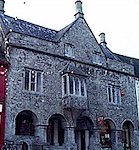
















|

Rothe house was built in 1594.
It illustrates how the merchants of Kilkenny lived over
their shops and how the streets of the city were lined
with arcaded footpaths. The footpath ran within the five
round-headed arches the full length of the east frontage and
the shop occupied the remainder of the ground floor; the basement,
lighted by a series of small windows on the west side, was the store;
the living quarters occupied the lofty first floor and the bedrooms
were in the roof. Most of the evidence for the arrangement of the
living quarters was lost in the nine-teenth century, when Timothy O'Hanrahan
carried out extensive alterations, but the two original fireplaces and
the numerous windows suggest that the first floor was divided into several
rooms; the oriel window is modern restoration based upon the tip of the
supporting stone corbel which had survived the alterations and the other
windows are based upon remains of the original stonework.
John Rothe FitzPiers and his wife Rose Archer belonged to minor branches
of two of the leading civic families of medieval Kilkenny. When he died in
1619 business was already being carried on by some of his eleven children
and their families.
The house is traditionally associated with the National Ecclesiastical Assembly
convened by Bishop Rothe, who was a cousin of John Rothe, in May 1642. This
meeting was attended by all the Catholic Bishops of Ireland with representatives
of the clergy. It led to the formation of the Parliament of the Confederation
in October 1642.
The Rothe family paid dearly for their association with the Confederacy.
The house was forfeited in 1653 and the Rothes transplanted to Connaught.
An Ormonde connection secured a reprieve in 1660 but the house passed
finally from the family in 1691. The survival of the building may be
partly due to the fact that it became a school in the 18th century.
The house was bought by Kilkenny Archaeological Society in 1962,
restored (under the supervision of Perey Le Clerc) and opened as a
museum and library in 1966.
|
 |
|





